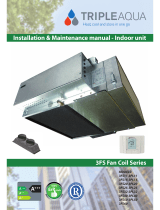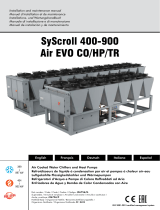
19
6. Commissioning
6.1 Preliminary inspections
6.2 First start-up or restart after long inactivity
6.3 Shut-down
6.4 Flow rate calibration
6.5 Flow rate balance
Preliminary precautions
6.1 Preliminary inspections
6.1.1 Electrical
• Verify the voltage on L1, L2 or L1, L2, L3 terminals is that indicated on the unit plate
(tolerance allowed) ±5% verifiable with a tester. If voltage changes occur frequently, please
contact our technical department to choose suitable protections.
• Check the connecting cables connected securely.
• Check pipe connection sections thermally insulated.
• Check the earthing lines connected securely.
6.1.2 Hydraulic
• Make sure that the water circuit has been previously cleaned: it is recommended to wash
the water circuit via by-passing the unit and then check the cleanliness of the system filter.
• The machines are shipped with open vents and drains, which must be closed during
installation when filling the water circuit. Labels indicate their positions.
• Make sure that the hydraulic system has been bled, thereby eliminating any residual air. The
operation must be performed by loading gradually and opening the venting devices set up by
the installer in the upper part of the system.
• If you are using glycol water you can move the antifreeze set-point. The value must be equal to
the value of the freezing temperature of the fluid plus 6K.
• Check no hot water socket above the regular socket.
• Check the equipment and main pipe connection sections free of circulating water leaks.
6.1.3 Cooling
• Check that there is no refrigerant leak, possibly using a leak detector.
6.2 First start-up or restart after long inactivity
6.2.1 Start-up
Activate the machine according to that described in the relative command section.
6.2.1.1 Checks during operation
• Check that the machine does not generate abnormal noise or excessive vibrations.
• Verify that the machine operates within the optimum working range.
• A few minutes after the compressors are started, during the summer mode cycle, make sure
that the condensing temperature is 18±4K higher than the air temperature entering the
condenser and that the average evaporating temperature is approximately 5K lower than the
water temperature leaving the utility exchanger.
• Verify that the overheating temperature of the refrigerant is between 5 and 7K. To verify:
Measure the temperature with a contact thermometer placed on the intake pipe of the
condenser.
• Verify that the subcooling temperature of the refrigerant is between 4 and 8K. To verify:
Measure the temperature with a contact thermometer placed on the outlet pipe from the
condenser.
• The initial start up of the chiller must be carried out by the Technical Support.
• Make sure that all safety conditions have been complied with.
• Make sure that the unit has been adequately fixed to the support surface.
• Make sure that you have complied with the clearance area.
• Make sure that the water connections have been implemented according to the instruction
manual.
• Make sure that the hydraulic system is filled and vented.
• Make sure that the shut-off valves of the water circuit are open.
• Make sure that the electrical connections have been implemented correctly and that all
terminals are tightened.
• Make sure that the earthing has been implemented correctly.
• Make sure that the all the electrical connections have been tightened correctly.
6.3 Shut-down
6.3.1 Temporary shut-down
Disable the machine according to that described in the relative command section.
Avoid to remove voltage using the switch on board or the main switch of the plant.
Voltage loss do not allow the antifreeze heater operation with the consequent risk of
freezing.
The antifreeze protection function is only active if the unit is in “STAND-BY” mode. In case of
operation, the unit controls pump start-up.
To safeguard the system and the units, we recommend installing an electrical heater on the
connection pipes, or to fully empty the system.
6.3.2 shutting down for long periods;
Not using the unit for a long period of time requires the following operations to be performed:
• Disable the unit in any mode of operation it may be, from the control panel.
• Set the remote switch to “OFF” (if present) after having turned off the unit.
• Disable the internal terminal units by setting the switch of each unit to “off”.
• Set the main switch of the system to ‘’off’’.
• Close the water valves.
If, during the period of inactivity the temperature drops below zero, the system must be
fully empties or topped up with antifreeze liquid.
6.4 Flow rate calibration
Once the pump has started, verify that the fluid flow rate of the utilities is within the expected
values for the unit.
To verify:
• Verify the temperature difference between fluid utilities inlet and outlet when the unit works at
full capacity.
• The difference in water temperature between input and output must be between 4° and 6°C:
If lower than 4°C, the water flow is too high: slightly close the shut-off valve placed on the
pump delivery, plant side, coming out of the machine.
If higher than 8°C, verify the pressure drops on water circuit.
6.5 Flow rate balance
When there are multiple units in parallel, the ΔT of the water produced by the machines turned on
must be checked.
It may occur that the units closer to the pump produce a ΔT<5°C (high flow rate), while the units
farther away may produce a ΔT>5°C (flow rate lower than nominal values).
To correct the potential flow rate offset, the shut off valves on the inlet and outlet of each machine
must be operated on.
Slightly close the valve on the units with high flow rate and make sure the shut off valves on the
units with lower flor rate are fully open.























